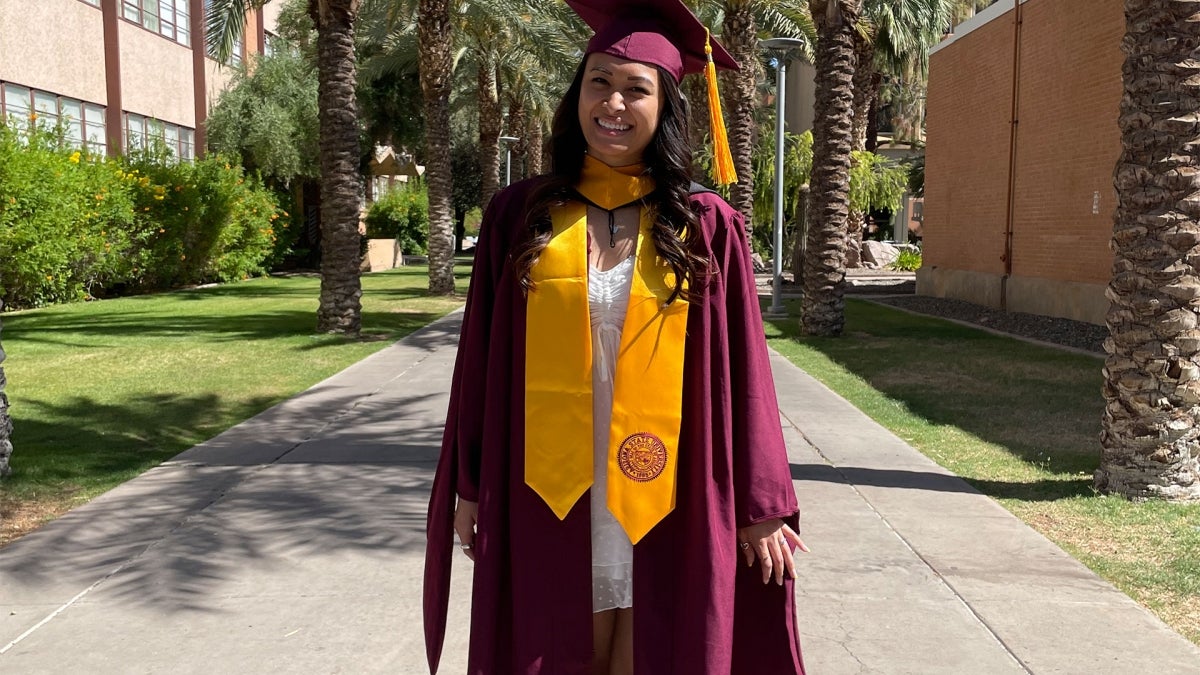ASU grad makes a difference in the lives of children with autism

Sami Shah, a recent graduate of the master’s in applied behavior analysis program in the ASU Department of Psychology.
Sami Shah, a recent graduate of the Master of Science in applied behavior analysis program in the Arizona State University Department of Psychology is one of the first graduates of the synchronous learning option offered by the program.
This option was launched in 2020 and allowed students living outside of the Phoenix metro area to experience live courses with classmates while conducting their practicum training in another city or state.
Shah, a psychology graduate from Ohio State, enrolled in the program while living in Ohio and working for Hopebridge, a national autism therapy center for children. She is currently a case manager at Hopebridge in Gilbert.
She always had the drive to help children, and after working as registered behavior technician, she found that she was thinking about the children and their plans when she was off work and realized it really was a passion.
“I got more invested in what I was doing, I enjoyed it more, and I found myself thinking about work when I wasn't working,” said Shah, adding, “I realized that I'm actually passionate about what I am doing, so why not go back to school for it?”
In order to take the next step in helping children with autism, she knew that she needed to become a board certified behavior analyst, and that required a master’s degree in behavior analysis.
Related: Learn about applied behavior analysis from ASU alumni
Shah weighed doing an online program versus a simulcast program, and decided that the live interaction was something she needed.
One of the biggest features that made ASU a good fit for her was the included practicum, or hands-on clinical training hours. In addition to the course hours, the program has a requirement for 2,000 practicum hours.
Students work at partner facilities to provide services to children and families, and gain experience with mapping out behavior plans and working in the field. Separately, the faculty then meets with the students to discuss what they experience at their respective practicum sites, and they are able to benefit from the shared experiences as a cohort. These practicum hours also enable graduates to sit for certification upon program completion and be eligible for state licensing once certified.
In the other programs she was looking at, students would graduate with the required coursework but still have to complete 2,000 hours after graduation in order to meet the qualifications for licensure.
“I didn't want just an online program, I wanted something more focused and structured. After speaking with Don Stenhoff, the program director, and hearing other people’s experiences with different schools, I decided to apply,” Shah said. “One of the big benefits of the live instruction was that we were able to ask important questions in the moment versus emailing and having to wait.”
It was clear to the program faculty that Shah excelled in this environment.
“Sami began the program with great interest — a benefit of this simulcast program is students foster those skills we are teaching with immediate feedback from their professors. It also provides them with the opportunity to increase their analytic and leadership skills in a group structure, in which Sami succeeded,” Stenhoff said.
Shah hopes to continue working in a center like Hopebridge, where patients arrive at the facility for treatment regularly, but can also envision owning her own practice in the future.
“The most rewarding part for me is that I’m able to make an actual difference in the lives of children and families. Watching my treatment plans succeed and help these kids is just so exciting,” Shah said.
More Science and technology

ASU postdoctoral researcher leads initiative to support graduate student mental health
Olivia Davis had firsthand experience with anxiety and OCD before she entered grad school. Then, during the pandemic and as a…

ASU graduate student researching interplay between family dynamics, ADHD
The symptoms of attention deficit hyperactivity disorder (ADHD) — which include daydreaming, making careless mistakes or taking…

Will this antibiotic work? ASU scientists develop rapid bacterial tests
Bacteria multiply at an astonishing rate, sometimes doubling in number in under four minutes. Imagine a doctor faced with a…